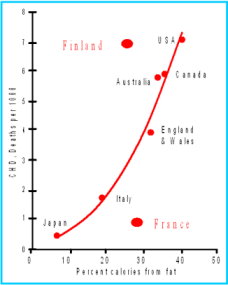Saturated fat and coronary heart disease
Part 1: Ancel Keys's 'lipid hypothesis'
In 1953 an Americal doctor, Ancel Keys, suggested that a fatty diet might play a part as a cause of CHD.[1]
Using data from just 6 countries (those named in black), Keys compared the death rates from CHD and the amounts of fats eaten in those countries to demonstrate, he said, that heart disease mortality was related to fat intake. As the graph below shows, there is an almost perfect fit.
And so the 'lipid hypothesis' (lipid is a word that encompasses fats, waxes and sterols) was born. However, at that time, data from another 16 countries were available. If they are added the picture is a lot less clear.
For example, Finland near the top has 7 times as many deaths as France, yet Finns eat less fat. These are two of the countries Keys didn't use.
Despite its faults, some of which didn't become apparent until later, Keys had what looked like a plausible hypothesis to explain the high levels of heart disease in some countries.
Now, anyone can have a hypothesis. What you have to do then is prove it. In medicine, the usual way is to select two groups of people, as identical for sex, age, and lifestyle as possible. One group, called the intervention group, tries the new diet, drug or whatever, while the other, called the control group, carries on as normal. After a suitable time, the two groups are compared and differences noted.
Keys' 'fatty diet-causes-heart disease' hypothesis was persuasive, but was it true? To test it, many large-scale, long-term, human intervention studies were set up in many parts of the world. These involved hundreds of thousands of subjects and hundreds of doctors and scientists and cost billions of dollars in an attempt to prove that a fatty diet caused heart disease.
What they found was the opposite of what they expected.
Reference
1. Keys A. Atherosclerosis: a problem in newer public health. J Mt Sinai Hosp 1953; 20: 118.
